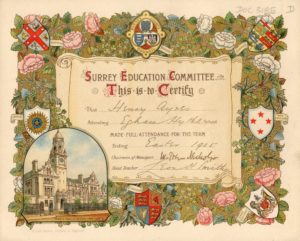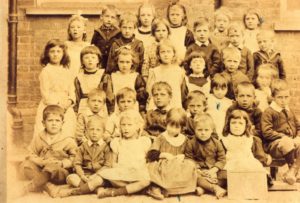Educating Egham Part 3
Read part 1 here and part 2 here
School Rules
Attendance: from the Egham School Board Bye-Laws 1901
No 2: “The parent of every child of not less than 5, nor more than 14 years of age, shall cause such child to attend school, unless there be a reasonable excuse for non-attendance” (illness, alternative education provision, no public elementary school within 2 miles)
No 5:”(a) A child between twelve and fourteen years of age shall not be required to attend school if such child has received a certificate from one of His Majesty’s Inspectors of Schools that it has reached the VI Standard [in reading writing and arithmetic] prescribed by the Code for the time being.

(b) When a child between twelve and fourteen years of age, being beneficially employed to the satisfaction of the Local Authority, has either (i) received a certificate from one of His Majesty’s Inspectors of Schools that it has reached the V Standard prescribed by the Code for the time being.
Or (ii) obtained a certificate that it had made 300 attendances in not more than two schools in each year for five preceding years whether consecutive or not. Such child may, while regularly making five attendances in each week in which the school is open, be exempt from further attendance at school.
No 6: Every parent who shall not observe, or shall neglect or violate these Bye Laws, or any of them, shall, upon conviction, be liable to a penalty not exceeding, with the costs, twenty shillings for each offence.”
Appearance: from the Rules of St Jude’ School at its foundation in 1827
“Children must come with clean hands and face, their cloathes mended and hair cut short, plain in their dress”

Behaviour
Children were expected to be quiet, hard-working and respectful. Depending on their seriousness, transgressions would be punished by lines, detentions, dunce’s cap, standing in the corner or even the cane. These would be recorded in a punishment book.
School Memories
“When I first went to school I wore a white pinafore with an embroidered yoke over my dress and a handkerchief pinned to it.”
Ellen Hall, Bishopsgate Infants School 1912
“Englefield Green School had about 100 girls and about the same number of boys. We had three teachers and Miss Marcham the headmistress. Learning was done by rota… Most pupils in those days left at 14, but we stayed on until we were 15. I did because I knew we were leaving Englefield Green… [We] were rather bitter in later life that it was never suggested we try for scholarships. I am sure that we were as good as the few who did go to Chertsey Grammar School. I suppose our parents could not afford the train fare, and uniform, and in my case would have been thinking of my brother, who showed every sign of being brilliant.”
Ellen Hall, St Jude’s 1916-23
“Every year at Strode’s there was the Edwin Budgen Scripture Prize. One year I decided I would win it (never having won a prize). The subject was ‘Moses, leader and lawgiver.’ My approach to his laws was a practical one – pork and shellfish are dangerous in a hot climate etc. Scripture master Mr Tucker told me in front of the form that I had won the prize but later had the embarrassing task of telling me I had not as Mr Gittins had decided that it would be inadvisable to pass my essay on to Mr Budgen.”
John Raincock, Strode’s, 1940s
“The two lower years of the school had been sent to Egham and we were accommodated by Strode’s College. There could have been friction between the schools at this intrusion, if not among the staff, then at least among the boys, but we seemed to get on quite well together, or perhaps were indifferent to each other’s existence… when the weather permitted, we used to troop over to the Thames on Wednesday afternoons for swimming.”
Michael Zeffert, evacuated from Raine’s School to Strode’s, 1940s
“I went to Manor School, a school here in Egham. We had school dinners in the place in front of where the library is now. I did cookery and woodwork in the institute at the bottom of Egham Hill, boys alternated with girls.”
Carole Lakomski, 1950s
“I …attended Runnemede House School beginning January, 1963… I was one of the Australians… We loved that school and were devastated when it all came to an end in 1967. Apparently the building was condemned, although there was also a scandal which may have been partly responsible for its demise. My maiden name was Helen Cox and we lived then in Virginia Water.”
Helen Pratt, 1960s
“Living conditions [at Scaitcliffe] were probably poor even by normal prison standards. We slept on straw mattresses on old spring bedframes that had become hammock-like as a result of being slept on by several generations of young boys. The floors were made of a substance called lino and were freezing cold, especially in winter. This was exacerbated by the policy of the school Matron, who was firmly of the belief that young boys needs lots of fresh air and as a result the windows were opened wide every night. Our beds were only supplied with two blankets and as a result I would sleep wearing my vest, pyjamas and dressing gown in an effort to stay warm. On some mornings the water in the cup next to my bed was a solid block of ice.”
Michael Swain, 1960s

